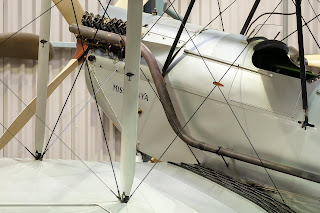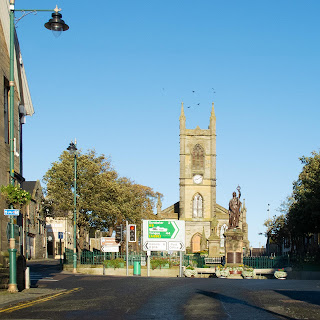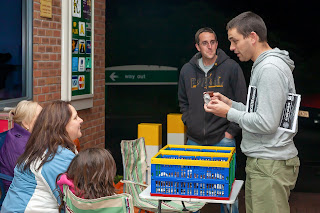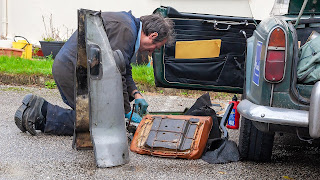Having done the RBRR twice before I was longing for
another go. I’d hoped for a three man team in Roger’s Mk1 saloon, but sadly
Roger and Robbie decided to enter with Roger’s GT6 instead. Which meant no
three man team from the Netherlands. This also meant I had to find another way
of entering. In the end I teamed up with Howard B and his TR7 DHC. So after two
runs in a GT6, I would be doing the event in a for me rather familiar car, be it
with the steering wheel on the wrong side 😜
So the day before the event I flew to London Stansted
were I was picked up by Howard. When we drove to his house the car felt very
nice. But while doing some last checks on the Friday morning, we found out the
engine was idling on only two cylinders. First impression was that there was
something wrong with the ignition. But just to be sure I had a quick look at
the carburettors. Lifting the piston of the rear carburettor cured the problem
completely, so clearly something wrong there. As there could be several causes
for this, and the car had only been there two weeks earlier for a tune up, we
decided to drive over to Robsport for a quick check of the carburettors.
Turned out that the jet from the rear carburettor
wouldn’t return to its normal position after the choke was pushed back. As we
wouldn’t need the choke much in the next few days, we decided not to bother too
much. So after a cup of tea and a chat with the friendly staff at Robsport we
headed for The Plough. But not before we received some sponsoring, not for Mind
but more for peace of mind (in the form of a few service items “just in case”).
Also added some extra stickers to the car.
By the time we reached the Plough, the rain had
settled into a rather miserable heavy drizzle. So after a good meal we were
glad we could get into the car at last, to be flagged of for the first stage to
Blyth services, at around 18.30. As usual this isn’t the most exciting part of
the run, and as it is Howard’s back yard he was driving, making life for me as
a navigator quite easy. As there were no traffic jams on the route and the car
was running as it should, we reached Blyth control ahead of schedule. So a
little time to have a chat with a few people and receive last year’s 10CR
finisher awards from Burnerboy.
With all formalities completed it was time for me to
take over the wheel, for the next stage to Edinburgh Airport. Luckily the rain
had stopped by now, making driving conditions fairly good. Although I was a bit
careful because the roads were still wet and slippery in places, I didn’t want
to write off someone else’s car. And everything went pretty well all the way up
to Edinburgh. Although fairly soon after we turned off the A1 onto the A68 I
ran into a small problem that would haunt me right till the end of the event. I
had problems with the gear change. At first I thought it was because I wasn’t
accustomed to changing gear with my left hand, but after a while I noticed that
the gear lever had quite a lot of play, even when in gear. So Howard had to get
used to me swearing quite a lot, because changing into 3rd gear became a bit of
a lottery, like stirring a ‘box filled with gears and see which is selected! But
apart from this small fault the car performed rather well, with a very nice
balance between comfort and handling. Especially bearing in mind that it is
more or less standard, the only upgrades being poly bushes and some beefier
brakes up front.
At Edinburgh Airport Howard took over again, and after
crossing the Firth of Forth and hitting the A9 I went into shut-down mode, as
is already customary for me on this stretch. So only a few vague recollections
off Triumphs hurrying past and lorries being overtaken. For me this meant that
we reached the next stop, Skiach Services, in no time at all.
As we were still ahead of schedule we had time to
relax a bit, before the road books would be signed. But by 5:50, and with me
stirring the gears again, we were back on the move. For me this stretch of the
RBRR is one of my favourites. Always great to drive along Scotland’s
north-eastern coast up to John O’Groats, with the light of a new day coming in
from the North Sea. Especially as it turned into a rather un-Scottish beautiful
morning. And with the Sun slowly emerging, the road conditions could be judge
much better. So we again made good progress, reaching the Seaview Hotel in John
O’Groats less than two hours after we left Skiach. We were still well ahead of
schedule. This left us with plenty of time to have breakfast, relax a bit and
make some more photo’s!
With the photo shoot done and in glorious sunshine, we
headed west onto the A836. As the weather forecast for the event had been
rather poor, we had left the hood stowage cover at home. Sadly without the
cover the hood will start flapping in the wind at around 50 mph, so we couldn’t
put the hood down to enjoy the weather. But it was rather enjoyable
nevertheless.
Shortly after filling up the car at a small petrol
station in Betty Hill we turned left onto the B871. The road running parallel
with the River Naver and Loch Naver. Certainly one of the best stretches of
this edition of the RBRR. Beautiful scenery, a great road with hardly any
traffic and glorious sunshine, what more do you want!?
Just past Loch Naver we re-joined the A836, and headed
south toward the next stop, Conon Bridge. During this part of the run the
clouds gradually moved in, but it remained dry. Almost looked like the weather
knew how to behave itself. Which could also be said of the car, which kept on
going without any problems. This couldn’t be said of McJim’s GT6 which seemed
to have problems with the rear brakes.
From Conon Bridge we headed further South till we hit
the shores of Loch Ness. Sadly we again didn’t catch a glimpse of the monster!
From here we turned right onto the A82 and followed the shore to the West.
Although there were a few rain showers the weather conditions remained pretty
good for Scotland. It was a good drive, and by now I had accustomed a bit to the
car’s slightly random gear change.
We followed the A82 all the way over Glencoe, were it
rained of course. Well it was more of a down pour, reducing visibility but
mainly the speed of the other (Sunday) traffic rather dramatically. At least
the other drivers were driving so slow, that they could be overtaken quite
easily and safely. Although in some places there was so much standing water on
the road that the car started to aquaplane. Always slightly scary! Luckily the
weather cleared after Glen Coe, making the rest of the section to Stirling
again a rather pleasant affair.
We only managed to annoy one of the other teams
slightly when turning of the M9 south of Stirling. I was struggling with the
gears again, as a result of which I went wide a bit. At least I had the
indicator on in the correct direction so he should have been warned about the
direction I wanted to take!
After the pies in Stirling Howard again took over for
the very boring section to Lancaster services. I was in shut down mode again so
not much to report. It was nice to have a short chat with Martin Randle (aka
Raider) at the control stop. With all formalities sorted, and after a large
coffee, I was ready for the next section to Gledrid. Also not much to report
there, as it was motorway all the way. The stop in Gledrid itself was again
very nice with a friendly atmosphere, and of course some light spannering going
on.
After Gledrid it was up to Howard to enjoy himself on
the fabulous roads through Wales. The fact that the weather and the driving
conditions were still pretty good, certainly helped with the enjoyment. This
time the route through Wales was divided in two shorter sections with a control
stop right in the middle of Welsh’ nowhere, the Sugar Loaf Halt. Glad I put the
exact coordinates of the halt in my GPS, making it rather easy to pinpoint it
in de dark. As there was a slight drizzle in the air, we were glad that we
weren’t too much ahead of schedule, so we didn’t have to wait too long for the
control to open. So as soon as we got the road book signed, we were on our way
again. As Howard really got the hang of the Welsh roads, I made myself
comfortable in the passenger seat and tried to rest as much as possible.
After crossing the Bristol Channel I fell asleep only
to be awakened when Howard left the Gordano stop, heading for Land’s End. As he
still felt very well we agreed that he’d carry on for a while. So I went back
to sleep, to be woken up just before Exeter by some strange movements of the
car. Turned out that the weather had deteriorated badly, with very heavy rain
and a gale force wind. Not really what you are hoping for on the second night
of the RBRR. It was clear that these conditions had taken their toll on Howard,
as he looked rather knackered. Luckily we were right up to a service station,
so we pulled into that to swap places.
The moment we set of again Howard was fast asleep and,
although fully rested I missed the road sign for the A30. OK visibility was
rather poor, but that was hardly any consolation when I realised the mistake.
Sadly I only found this out shortly before we reached the point where the A380
forks of the A38. A quick wake up call to Howard got him into the maps, but by
now I had taken another wrong exit. Luckily Howard managed to pinpoint our
position on the map, and led us back to the A38. Sadly shortly after we joined
the A38 we ran into a Police road block. Turned out that a little further on,
the road was flooded. And no, we wouldn’t be able to carry on, as there was 2
ft of water on the road ( we should have taken the Land Rover 😁). Nothing we
could do about it but take the suggested diversion.
Turned out to be a lovely but very narrow and twisty
country lane. Under normal conditions I wouldn’t mind this, but the weather was
still rather bad, with lots of branches on the road, and we were starting to
run late for the halt at Land’s End. And the road that, according to the police
officer, should bring us back onto the A38 turned out to be no more than a
track. We eventually did find our way toward Land’s End, joining the A30 again
at Summercourt.
It had been a nice drive but I was glad we were back
on a through road again. Soon after we got onto the A30 we passed another
Triumph. At least we weren’t last. But with still half an hour to go to Land’s
End we started to encounter the first participants who were heading for
breakfast in Scorrier! But in the end we reached the End. And still within the
scheduled time window!
By now the rain had stopped almost completely, and as
we headed north for the new breakfast stop at the Crossroad Lodge in Scorrier
it stopped all together. When we arrived in Scorrier it was clear that the run
was starting to take its toll on the cars, as there was some frantic spannering
going on in the parking area, with jobs ranging from electrical problems,
through wheel bearings to gearbox’s!
After breakfast and the signing of the road book
Howard did a check of all the vital parts of the car. He found nothing
disturbing. So with the knowledge that the car was in good health, we left for
the next control stop, Bude Castle. This turned out to be a very nice control
halt indeed, as a result of which we lost even more time.
As we were now running dangerously close to the end of
the time window, I decided to press on a bit towards to next halt, Badgers
Holt. Managed to get there with minutes to spare.
From here it was rather straight sailing to Pimperne
for lovely cakes and tea. Really was a shame that we were running late, as we
couldn’t taste all the cake varieties. So after a small but lovely selection of
cakes, it was my job to bring the car back to the Plough. By now I had slightly
accustomed to the rather awkward gear change, as a result of which I could keep
up a decent pace. Managed to get almost 15 minutes off the time, reaching
Didcot with slightly more time to spare.
With the road book signed we immediately started on
the last section, home to the Plough. Actually the roads after Didcot were
quite good fun. But as we were quickly running out of daylight, and I managed
to roll into the back of another car at some traffic lights (oops, sorry! 😳) we
decided it was time to hit the motorway, and take the easy way home.
We returned to the Plough at 20:23. Needless to say we
had a few beers on that, before heading to the hotel. And the car? Except for
the problems with the gear change it performed faultlessly over 3224
kilometres. Was really nice to drive an almost standard but well sorted TR7.
Edited 1st of
October 2020: As it is 10 years ago
that we set of for my 3rd RBRR, this time in Howards TR7, I decided to freshen up the pictures using the
original digital “negatives”. Also added a few extra pictures and edited the
text where necessary.




















































